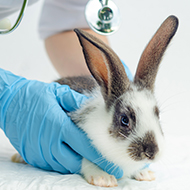
The advice is designed to help practitioners select the most appropriate drug.
New best practice guidance on the responsible use of antibiotics in rabbits has been published by the BSAVA in collaboration with the Rabbit Welfare Association & Fund (RWA&F).
The guidance is free and has been produced to help veterinary practitioners select the most appropriate antibiotic for rabbits. It covers active substance, dose and route of administration — all of which are crucial factors when treating rabbits owing to the risk of enterotoxaemia.
Building on the 2024 PROTECT ME poster for rabbits, the guidance also provides advice on diagnosing bacterial infections, likely casual organisms, and appropriate and non-antibiotic management. Ear disease, facial accesses, dacryocystitis enteritis, urinary tract disease, and upper and lower respiratory tract disease are also covered.
One of the authors of the guide, John Chitty, said: “Choosing an antibiotic for rabbits is not simple. Their diseases do not necessarily mirror those of dogs and cats, and they do have gut sensitivities to certain antimicrobials. However, like dogs and cats, there are situations where antibiotics are not needed where we once thought they were.
“This is especially important in reducing antibiotic usage in rabbits and, of course, in reducing use of critically important antibiotics in them as well. We hope this guide will help practitioners to see when antibiosis is needed, what choices are available and how to sample and select the most appropriate drug if needed.”
The guide is free to all and can be accessed via the BSAVA Library.
Image (C) Shutterstock.



 Zoetis has launched a new survey to identify management techniques for Equine Herpes Virus (EHV).
Zoetis has launched a new survey to identify management techniques for Equine Herpes Virus (EHV).